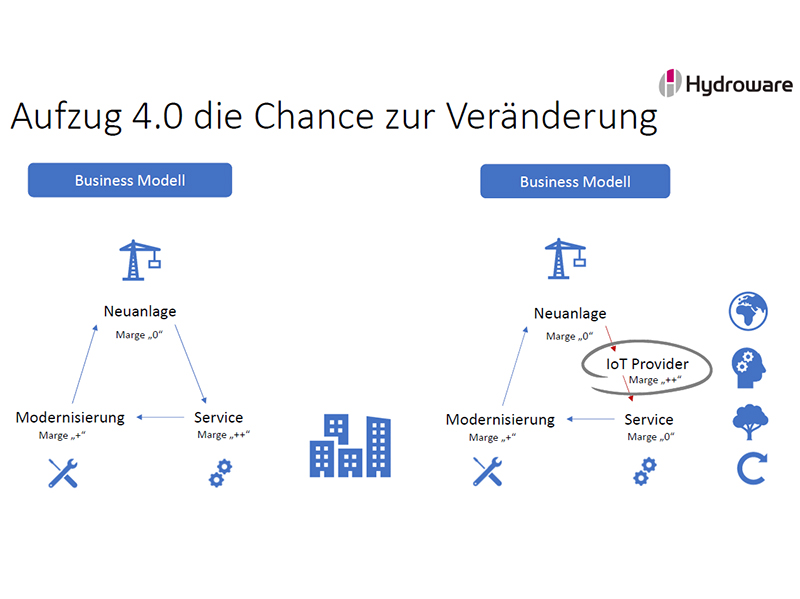Photo: © privat

News | April 2024
Obituary for Gerhard Thumm
Gerhard Thumm died at the end of February 2024 at the age of 72. He held various responsible positions at TK Elevator from 1976 to 2018.

Third parties will get into the game, once maintenance has been digitalised. And they are above all interested in one thing: data. (Photo: © B&M Noskowski, Aleksei_Derin / iStock.com / Getty Images / Montage)
June 2019
IoT, digitalisation, Lift 4.0 – catchwords that are still fairly abstract for many in the industry and which they are hesitant to get involved with.
Volker Hager has been dealing with these subjects for many years – and is now a sought-after speaker.
Let's be honest: our business is lucrative. Money is earnt primarily in service and maintenance. Modernisation also provides attractive margins. New construction of lifts is different: there is almost no profit margin there. But as is always the case when the barriers to entering a market are low and the margins are high: everything wants a little bit of the action.
What does this have to do with digitalisation? Let's take maintenance: not much has happened here in the last 30 years. Work is often still performed with the classic checklist. But this is currently changing – everyone is talking about "predictive maintenance".
But as soon as maintenance becomes digitalised, third parties get involved, so-called IoT providers. What the providers have been lacking to date is expert knowledge. But with digitalised maintenance, the old maintenance companies will lose precisely this expert knowledge and the big IT players will get into the game.
Then unique lift knowledge will no longer be needed – because the complex technology will no longer exist. There will still be mechanics who look after the lifts, but they will no longer have any system knowledge. Consequently, what we will need in future are highly qualified employees who understand the system.
You believe you will be spared by this development and it is not a threat to your business model? Then just think of the e-scooter a professor at the leading German technical university, RWTH Aachen, developed for the German post office – all of a sudden, the automotive industry had a competitor it had probably not expected.
Just like this, third parties will get into the game, once maintenance has been digitalised. For them, it does not matter what sector is involved: the data architecture is the same everywhere. And they are above all interested in one thing: data.
 Many operators willingly surrender this because they have no idea what they are agreeing to in their maintenance contract. By signing, they surrender the rights to the data that actually belongs to them. Correct: the data belongs to the lift. If it is sold or maintained, the data belongs to the buyer or operator.
Many operators willingly surrender this because they have no idea what they are agreeing to in their maintenance contract. By signing, they surrender the rights to the data that actually belongs to them. Correct: the data belongs to the lift. If it is sold or maintained, the data belongs to the buyer or operator.
But if the seller gives it away unknowingly, the buyer, and no longer the maintenance company, knows what's going on. Some company groups are now advertising that they will manage the data for the operator and in this way make everything more transparent for the latter. I rather doubt that: because you also only see what you are meant to see on the Internet.
Oh well, you might think, then we simply won't take part in digitalisation and go on working as before. A dangerous dream: because anyone who ignores this development will sooner or later be replaced by a competitor. Companies that are no longer part of an IoT portal in ten years will only be service providers - service providers which can no longer determine their business model themselves, i.e. the maintenance cycle and prices.
Anyone who wants to take part in the "Lift 4.0" development will need an IoT service provider. An individual small companie can only recognise anomalies and wear if an enormous amount of data is available to them and they can interpret it. It is no coincidence that data analysts and start-ups in the field of artificial intelligence are currently popping up all over the place.
Many only think of remote monitoring when it comes to Lift 4.0 and the Internet of Things. But a lot more is involved: the connectivity, the possibility to merge and use information from the building and information from the Internet. If, for example, 50 cups of coffee are drunk in a building, the lift could in future know that it was lunch time and many people would soon need the lifts.
In short, it is all about the flows of people in buildings. The next evolutionary step will be to link information from buildings with information from the Internet. If a high-rise building is close to an urban rapid transit station – what is to stop linking the lift controls with the timetable of the transport company? Voice control by users will also be of great importance in the future.
In view of these developments, small companies will only have a chance if they are innovative. The bad news: it will not be easy for the lift industry, because up to now, it has not been very innovative, it was simply not necessary.
The good news: we have enough time to adjust to this development – it's not going to happen overnight.And it's fun: because if you take the initiative, you are no longer the passenger, but instead, you are sitting in the cockpit and can help to shape developments. Everything else is too risky.
Volker Hager is the German managing director of the Swedish company Hydroware. The company develops, produces and sells high-tech drive and control systems for hydraulic lifts.
Write a comment